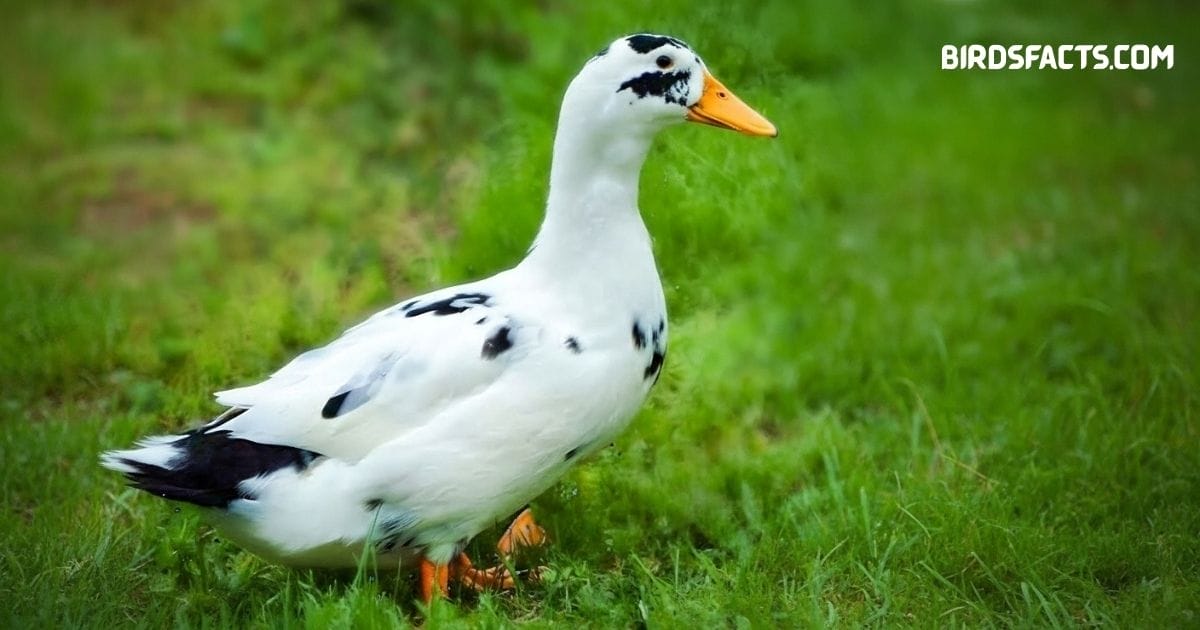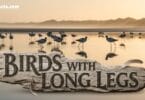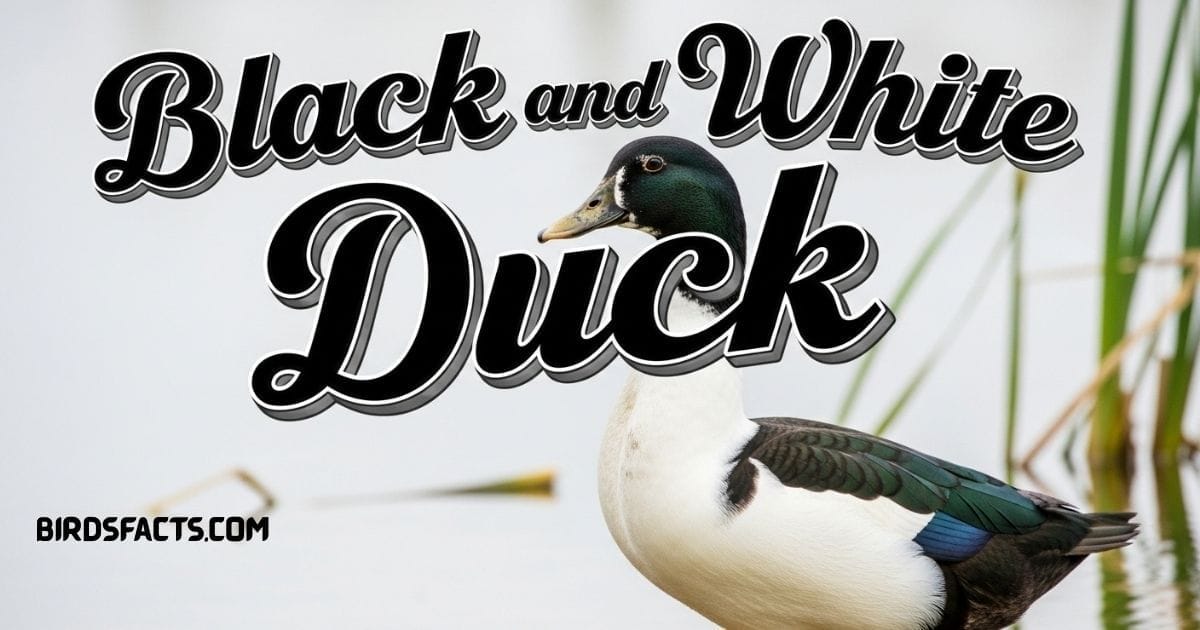
Black and White Duck
Have You Ever Been At A Park Or Near A Pond And Spotted A Duck With Striking Black And White Feathers Only To Wonder What Kind It Was? I’ve Had That Exact Moment Staring At The Water Feeling Curious And A Little Frustrated That I Couldn’t Name The Breed Right Away Ducks Are Everywhere, But The Truth Is Most People Only Recognize A Handful Of Them. That Curiosity Is What Leads Many Of Us To Start Looking Deeper Into Black And White Duck Breeds, Hoping To Finally Put A Name To The Birds We’ve Seen.
That’s What Makes Exploring These Ducks So Fun They’re Not Only Beautiful To Look At But They Each Come With Their Own Unique Story Traits And Role In Nature Or On Farms Some Black And White Duck Breeds Are Prized For Their Elegant Looks While Others Are Loved By Birdwatchers Or Backyard Keepers For Their Personalities And Usefulness. In This Guide We’ll Walk Through Some Of The Most Fascinating Breeds So The Next Time You See One Of These Striking Birds You’ll Know Exactly What You’re Looking At.
Black and White Duck
- Ancona Duck
- Barrow’s Goldeneye
- Bufflehead
- Common Eider
- Common Goldeneye
- Common Merganser
- Greater Scaup
- Hooded Merganser
- King Eider
- Lesser Scaup
- Long-tailed Duck
- Magpie Duck
- Red-breasted Merganser
- Ring-necked Duck
- Smew
- Spectacled Eider
- Surf Scoter
- Tufted Duc
- Velvet Scoter
- White-winged Scoter
Ancona Duck
Ancona Duck with mottled black-and-white plumage standing near water
The Ancona Duck Is One Of The Most Distinctive Black And White Duck Breeds Recognized By Its Mottled Piebald Plumage No Two Anconas Look The Same Their Patches Of Black And White Feathers Appear In Random Patterns Making Every Bird Unique. This Ornamental Beauty Is Not Just About Looks; It’s Also A Productive Domestic Duck That Lays Plenty Of Large Eggs. Many Small Farmers And Backyard Keepers Love The Ancona For Its Combination Of Beauty And Practicality.
These Ducks Are Hardy Calm And Adaptable To Different Climates. They Enjoy Foraging In Gardens Wetlands And Marshy Areas, Making Them Excellent Natural Pest Controllers. Because Of Their Broken Feather Patterns They Are Often Highlighted In Birdwatching Guides As Perfect Examples Of Patterned Waterfowl If You’re Beginning Your Journey Of Learning About Black And White Duck Breeds The Ancona Is One Of The Best Places To Start.
| Fact | Details |
|---|---|
| Habitat | Farms Wetlands Backyards |
| Diet | Grains Plants Insects While Foraging |
| Special Feature | Unique Piebald Black And White Markings |
| Fun Fact | No Two Ancona Ducks Have The Same Feather Pattern |
Barrow’s Goldeneye

Barrow’s Goldeneye duck with black-and-white plumage and golden eye swimming on a lake
Barrow’s Goldeneye Is A Striking Wild Black And White Duck Often Found In Northern Lakes And Rivers Males Display Glossy Black Heads With A Hint Of Purple Sheen, Paired With Bold White Patches On Their Sides And Wings Their Bright Golden Eyes Give Them Their Name And Make Them Even More Eye catching. Females Wear More Muted Brown Tones But Still Carry Distinctive White Facial Patches.
This Species Prefers Freshwater Habitats During Breeding But Moves To Coastal Estuaries During Winter. They’re Excellent Divers Feeding On Mollusks Aquatic Insects, And Small Fish With Fast Wingbeats And Strong Flying Ability Barrow’s Goldeneyes Are Known For Long Migratory Routes Birdwatchers Always Count Spotting This Rare Black And White Duck As A Memorable Moment.
| Fact | Details |
|---|---|
| Habitat | Northern Lakes Rivers Coastal Estuaries |
| Diet | Aquatic Insects Mollusks Fish |
| Special Feature | Bright Golden Eyes With Bold Plumage |
| Fun Fact | Known For Powerful Wingbeats During Flight |
Bufflehead

Bufflehead duck with white patch on head and black-and-white plumage swimming on a lake
The Bufflehead May Be Small, But It’s One Of The Most Delightful Black And White Duck Species To Watch Males Show A Large White Patch On The Back Of Their Glossy Dark Heads Giving Them A Helmet-like Appearance. Under Sunlight Their Feathers Shimmer With Green And Purple Hues. Females Wear Gray Brown Plumage But Carry A Distinct White Cheek Patch Making Them Easy To Recognize.
Despite Being The Smallest Diving Duck In North America Buffleheads Are Skilled Swimmers And Divers. They Feed On Insects, Crustaceans And Mollusks Often In Shallow Wetlands And Marshes Migrating Thousands Of Miles Each Year They Winter In The United States After Breeding In Canada Birdwatchers Love Their Energetic Flocks And Fast Wingbeats Which Make Them Exciting To Photograph.
| Fact | Details |
|---|---|
| Habitat | Wetlands Marshes Lakes Coastal Waters |
| Diet | Insects Crustaceans Mollusks |
| Special Feature | White Head Patch (Males) Cheek Patch (Females) |
| Fun Fact | Smallest Diving Duck In North America |
Common Eider
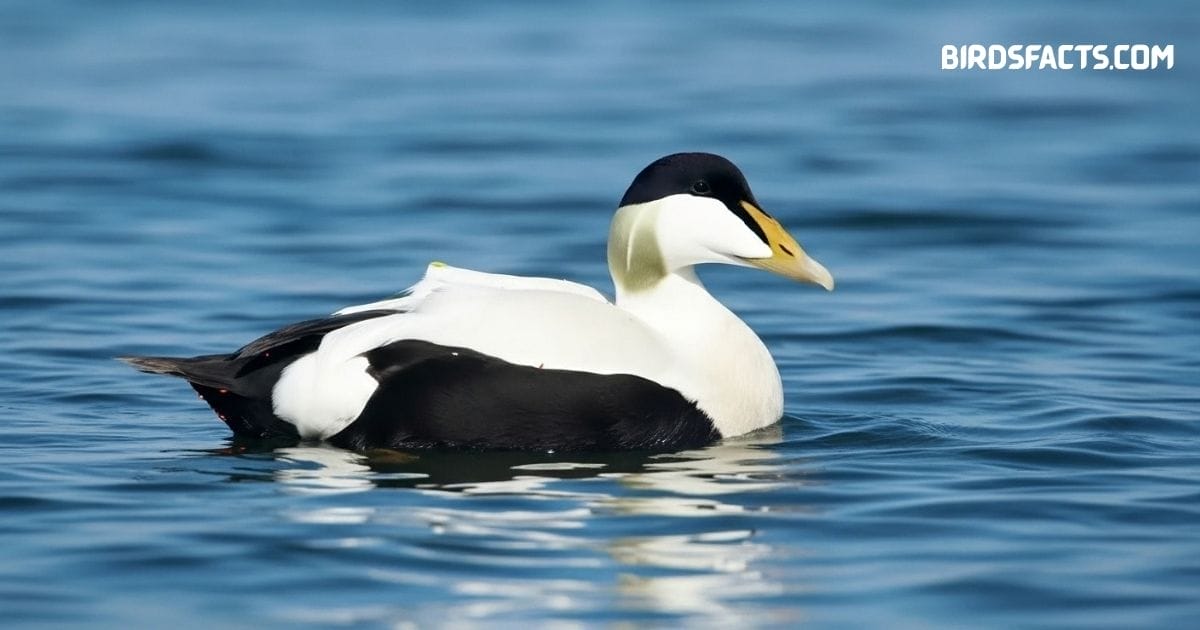
Common Eider duck with black-and-white plumage and sloping bill swimming on the sea
The Common Eider Is A Well known Sea Duck And Another Beautiful Black And White Duck Found In Northern Coastal Regions. Males Display Striking White Backs Black Caps And Touches Of Green On Their Necks While Females Are Dressed In Warm Brown Plumage That Blends With Their Environment. This Difference Between Sexes Called Sexual Dimorphism, Is Common In Waterfowl Species.
Eiders Are Famous For Producing The Soft Down Feathers That Humans Have Used For Centuries In Bedding And Warm Clothing. They Gather In Large Flocks Sometimes Numbering Thousands, And Dive Into Cold Ocean Waters To Feed On Crustaceans And Sea Urchins Watching These Ducks Along Rocky Coasts Is A Breathtaking Experience For Bird Enthusiasts Spotting A Common Eider Adds Yet Another Incredible Black And White Duck To Your Birdwatching List.
| Fact | Details |
|---|---|
| Habitat | Coastal Seas Rocky Shorelines Estuaries |
| Diet | Mussels Crustaceans Sea Urchins |
| Special Feature | Produces Highly Prized Down Feathers |
| Fun Fact | Flocks Can Include Thousands Of Ducks In Winter |
Common Goldeneye

Common Goldeneye duck with black-and-white plumage and golden eyes swimming on a lake
The Common Goldeneye Is Another Wild Black And White Duck That Birdwatchers Love To Spot In North America And Europe. Males Show A Dark Glossy Greenish black Head With A Round White Cheek Patch While Their Bodies Contrast Sharply With White Sides And Black Backs. Females In Comparison Have Gray Bodies And Chocolate brown Heads But They Still Retain The Same Striking Eye Color. This Makes Identification Much Easier, Even From A Distance.
Goldeneyes Are Known As “whistlers” Because Of The Unique Sound Their Wings Make During Flight. They Are Diving Ducks Feeding On Aquatic Invertebrates Fish And Plants. These Birds Are Often Found In Northern Breeding Grounds And Migrate South During Winter Seeing This Energetic Black And White Duck Diving And Surfacing Repeatedly In Lakes And Rivers Is A Treat For Birdwatchers And Photographers Alike.
| Fact | Details |
|---|---|
| Habitat | Lakes Rivers Northern Wetlands |
| Diet | Insects Mollusks Fish Plants |
| Special Feature | Distinctive Wing “Whistle” Sound |
| Fun Fact | Bright Golden Eyes Make Them Easy To Spot |
Common Merganser

Common Merganser duck with long slender bill and black-and-white plumage swimming on a river
The Common Merganser Is A Large And Powerful Black And White Duck Often Found In Freshwater Lakes And Rivers Males Have Striking White Bodies Black Backs And Glossy Green Heads Giving Them A Regal Look Females On The Other Hand Display Gray Bodies With Reddish brown Heads And Crests Despite These Differences Both Sexes Are Admired For Their Sleek Shape And Strong Swimming Ability
These Ducks Are Excellent Fish Hunters Using Their Serrated Bills To Catch Slippery Prey. They Are Often Seen Diving Deep Into Rivers And Lakes In Search Of Fish Making Them Favorites Among Birdwatchers Who Enjoy Observing Natural Hunting Behavior. Common Mergansers Are Also Known To Nest In Tree Cavities Which Surprises Many People Who Expect Them To Stick To The Ground. Their Combination Of Beauty And Hunting Skill Makes Them One Of The Most Fascinating Black And White Duck Species In The World.
| Fact | Details |
|---|---|
| Habitat | Rivers Lakes Freshwater Streams |
| Diet | Primarily Fish Also Aquatic Insects |
| Special Feature | Serrated Bill For Catching Fish |
| Fun Fact | Often Nest In Tree Cavities Near Water |
Greater Scaup

Greater Scaup duck with rounded head and black-and-white plumage swimming on a lake
The Greater Scaup Is A Medium Sized Diving Duck And Another Classic Black And White Duck Species. Males Are Recognized By Their Rounded Black Heads White Sides And Black Tails While Females Are Mostly Brown With A White Facial Patch. Their Clean Bold Patterns Make Them Stand Out Among Flocks Especially When Gathered On Open Water Bird Watchers Often Confuse Them With Lesser Scaup But Their Larger Head And Rounder Shape Help Distinguish Them.
Greater Scaup Are Strong Divers Often Reaching Depths Of More Than 20 Feet To Feed On Clams Mollusks And Aquatic Plants. They Migrate In Large Flocks And Can Often Be Seen In Coastal Bays Estuaries And Inland Lakes During Winter Because Of Their Flocking Nature And Striking Appearance Spotting A Group Of These Ducks Feels Like Witnessing A Synchronized Show Of Patterned Water Fowl. Among The Many Black And White Duck Breeds The Greater Scaup Holds A Special Place For Both Hunters And Bird Watchers.
| Fact | Details |
|---|---|
| Habitat | Coastal Bays Estuaries Inland Lakes |
| Diet | Clams Mollusks Aquatic Plants |
| Special Feature | Large Rounded Head Compared To Lesser Scaup |
| Fun Fact | Can Dive More Than 20 Feet Under Water For Food |
Hooded Merganser
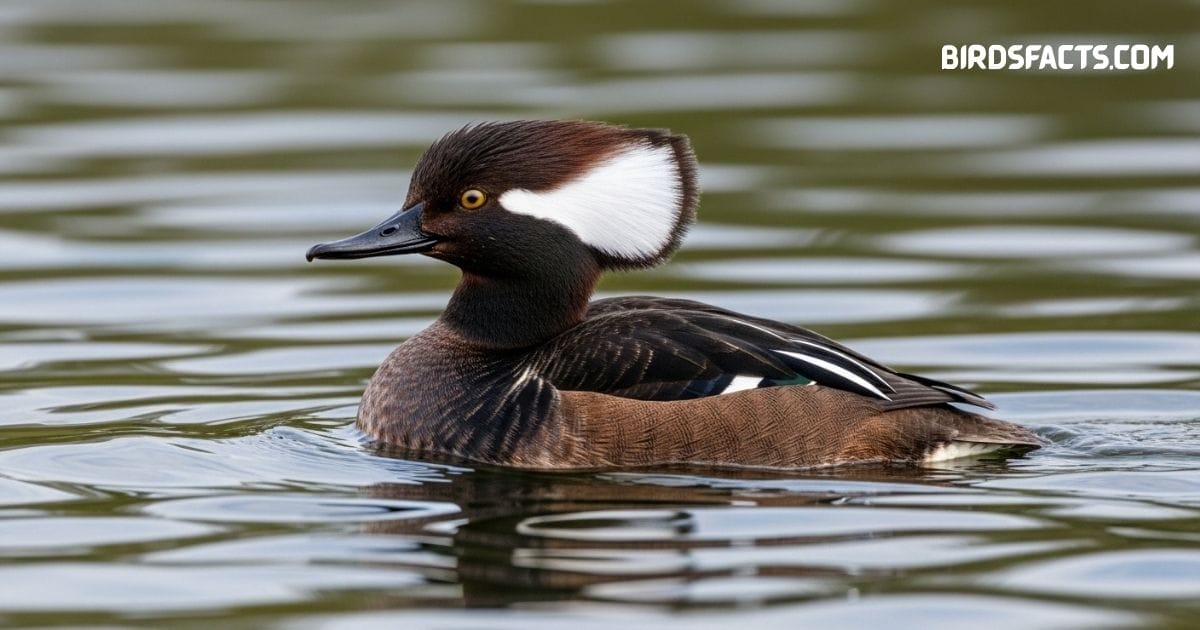
Hooded Merganser duck with striking black-and-white crest swimming on a pond
The Hooded Merganser Is One Of The Most Striking Black And White Duck Species In North America. Males Are Instantly Recogniz Able By Their Large Fan Shaped White Crest Bordered With Black Which They Can Raise Or Lower Like A Display. Females Are More Muted With Brown Bodies And Reddish Crests But They’re Equally Fascinating To Observe. These Ducks Often Leave Birdwatchers Amazed With Their Bold Looks And Active Behavior.
They’re Expert Divers Using Their Thin Serrated Bills To Catch Fish Crustaceans And Aquatic Insects. Unlike Many Other Ducks Hooded Mergansers Nest In Tree Cavities Near Water Making Them Unique Among Waterfowl Species. When They Fly Their Wings Create A Whistling Sound That Can Be Heard Before They’re Even Visible. For Bird Enthusiasts Spotting A Male Hooded Merganser With Its Crest Raised Is One Of The Most Iconic Black And White Duck Sightings.
| Fact | Details |
|---|---|
| Habitat | Lakes Rivers Forested Wetlands |
| Diet | Fish Crustaceans Aquatic Insects |
| Special Feature | Expandable Fan Shaped Crest (Males) |
| Fun Fact | Nests In Tree Cavities Close To Water |
King Eider

King Eider duck with colorful head and patterned plumage swimming in Arctic waters
The King Eider Is A Majestic Sea Duck And Another Breathtaking Black And White Duck Found In Arctic Regions. Males Are Known For Their Bold Plumage White Backs Black Chests And A Unique Orange Knob At The Base Of Their Bills. Females On The Other Hand Are Patterned In Shades Of Brown For Camouflage Blending Perfectly With Their Nesting Grounds. These Striking Birds Are Often Seen In Large Flocks During Migration.
As Strong Divers King Eiders Forage On Mollusks Crustaceans And Sea Urchins Beneath Icy Waters. They Travel Long Migratory Routes Some Times Forming Massive Rafts Of Thousands Of Individuals. Photographers And Bird Watchers Consider Them A Prize Sighting Due To Their Rare Distribution And Vivid Markings. Among All Arctic Water Fowl The King Eider Stands Out As One Of The Most Beautiful Black And White Duck Species.
| Fact | Details |
|---|---|
| Habitat | Arctic Seas Coastal Tundra |
| Diet | Mollusks Crustaceans Sea Urchins |
| Special Feature | Males Have A Bright Orange Bill Knob |
| Fun Fact | Sometimes Migrate In Rafts Of Thousands |
Lesser Scaup
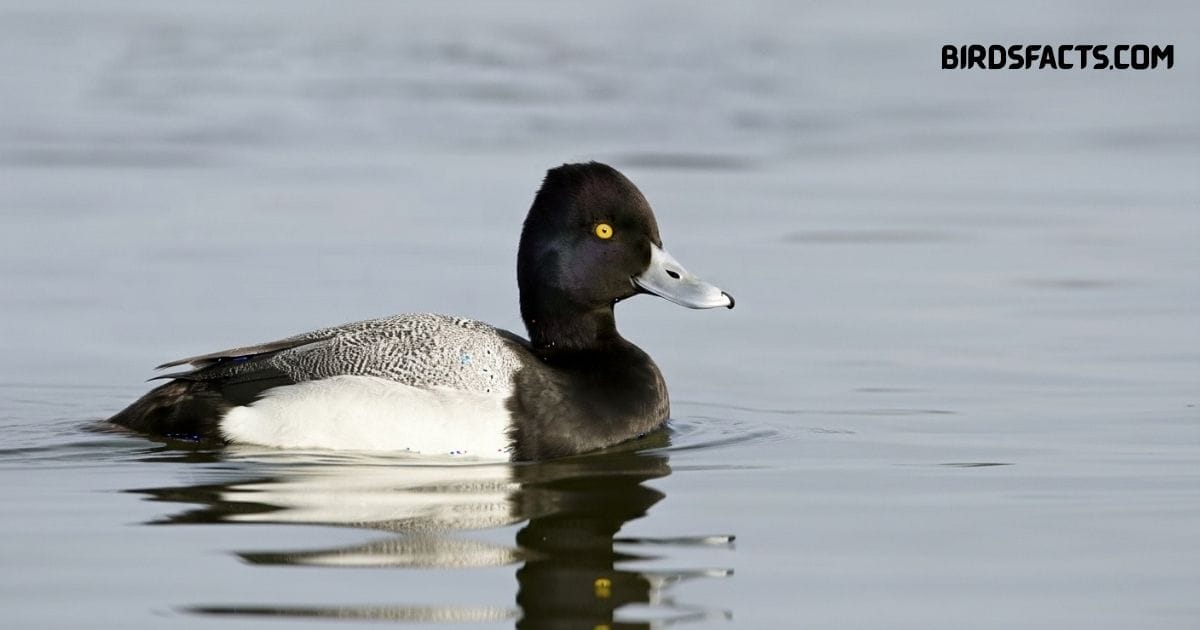
Lesser Scaup duck with rounded head and black-and-white plumage swimming on a lake
The Lesser Scaup Is Often Confused With Its Close Relative The Greater Scaup But It’s Still A Distinct Black And White Duck Worth Knowing. Males Display Black Heads With A Purple Sheen White Sides And Black Rears While Females Are Brown With A Notice Able White Patch Near The Base Of Their Bills Their Compact Size And Sharp Contrasts Make Them Easy To Identify For Experienced Bird Watchers.
These Ducks Are Expert Divers Feeding On Mollusks Insects And Aquatic Plants. They Gather In Large Flocks During Migration Often Joining Other Diving Ducks On Lakes And Coastal Waters Because Of Their Adaptability Lesser Scaups Are Among The Most Widespread Diving Ducks In North America. Spotting Them In Mixed Flocks Gives Bird Watchers Another Chance To Admire The Unique Beauty Of Black And White Duck Species In Motion.
| Fact | Details |
|---|---|
| Habitat | Lakes Reservoirs Coastal Bays |
| Diet | Mollusks Insects Aquatic Plants |
| Special Feature | Purple Sheen On Males’ Heads |
| Fun Fact | Often Migrates In Large Mixed Flocks |
Long-tailed Duck

Long-tailed Duck with striking plumage and long tail feathers swimming on the sea
The Long Tailed Duck Is One Of The Most Elegant Black And White Duck Species Found In Arctic And Northern Waters. Males Have Striking White Bodies With Black Wings And A Long Grace Ful Tail Feather That Gives Them Their Name. Females Wear More Muted Gray And Brown Plumage But Still Carry Distinct White Patches On Their Faces. Their Constantly Changing Seasonal Plumage Makes Them Fascinating For Bird Watchers To Study.
These Ducks Are Excellent Divers Capable Of Plunging To Depths Over 200 Feet To Feed On Mollusks And Crustaceans. During Migration, They Form Large Flocks That Fill The Sky With Their Whistling Calls. Long Tailed Ducks Are Often Seen In Coastal Seas And Estuaries During Winter Where They Become A Highlight For Bird Photo Graphers Among Arctic Water Fowl They Are One Of The Most Distinctive And Beautiful Black And White Duck Breeds.
| Fact | Details |
|---|---|
| Habitat | Arctic Seas Estuaries Winter Coasts |
| Diet | Mollusks Crustaceans Small Fish |
| Special Feature | Long Tail Feather (Males) |
| Fun Fact | Can Dive Over 200 Feet Underwater |
Magpie Duck

Magpie Duck with black-and-white plumage standing near a pond
The Magpie Duck Is A Domestic Black And White Duck Breed Originally Developed In Wales. It’s Easily Recognized By Its Sharp Contrast Of Black Plumage Across The Head Back And Tail Paired With White On The Chest And Belly. Their Feather Pattern Resembles The Markings Of A Magpie Bird Which Is How They Got Their Name. This Ornamental Breed Is Popular Among Backyard Keepers Because Of Its Beauty And Charm.
Magpie Ducks Are Not Only Attractive But Also Excellent Egg Layers Producing A Steady Supply Of White Eggs. They Have Friendly Personalities And Adapt Well To Small Farms Or Homesteads. With Their Tuxedo Like Feather Patterns They Are Often Used In Duck Shows And Exhibitions. For Anyone Interested In Keeping A Domestic Black And White Duck The Magpie Breed Is One Of The Top Choices.
| Fact | Details |
|---|---|
| Habitat | Farms Homesteads Backyard Ponds |
| Diet | Grains Insects Greens |
| Special Feature | Feather Patterns Resemble Magpies |
| Fun Fact | Known As Both Ornamental And Utility Ducks |
Red-breasted Merganser

Red-breasted Merganser with spiky crest and slender red bill swimming on water
The Red Breasted Merganser Is A Striking Black And White Duck Known For Its Spiky Crest And Color Ful Body. Males Have Dark Green Heads White Neck Rings And Reddish Brown Chests Making Them One Of The Flashiest Merganser Species. Females Are Gray With Reddish Brown Heads And Slimmer Bodies But They Retain The Same Energetic Behavior As The Males. Bird Watchers Often Find Them Along Coastal Waters And Estuaries.
These Ducks Are Skilled Hunters Using Their Serrated Bills To Catch Fish With Precision They Are Among The Fastest Flying Ducks Capable Of Speeds Up To 100 Km/h During Migration. Red Breasted Mergansers Are Also Highly Social Often Seen In Flocks Along Seacoasts And Large Lakes. For Bird Watching Enthusiasts Observing This Lively Black And White Duck In Action Is An Unforgettable Experience.
| Fact | Details |
|---|---|
| Habitat | Coastal Seas Estuaries Large Lakes |
| Diet | Primarily Fish Also Crustaceans |
| Special Feature | Thin Serrated Bill For Fishing |
| Fun Fact | Among The Fastest Flying Ducks In The World |
Ring-necked Duck
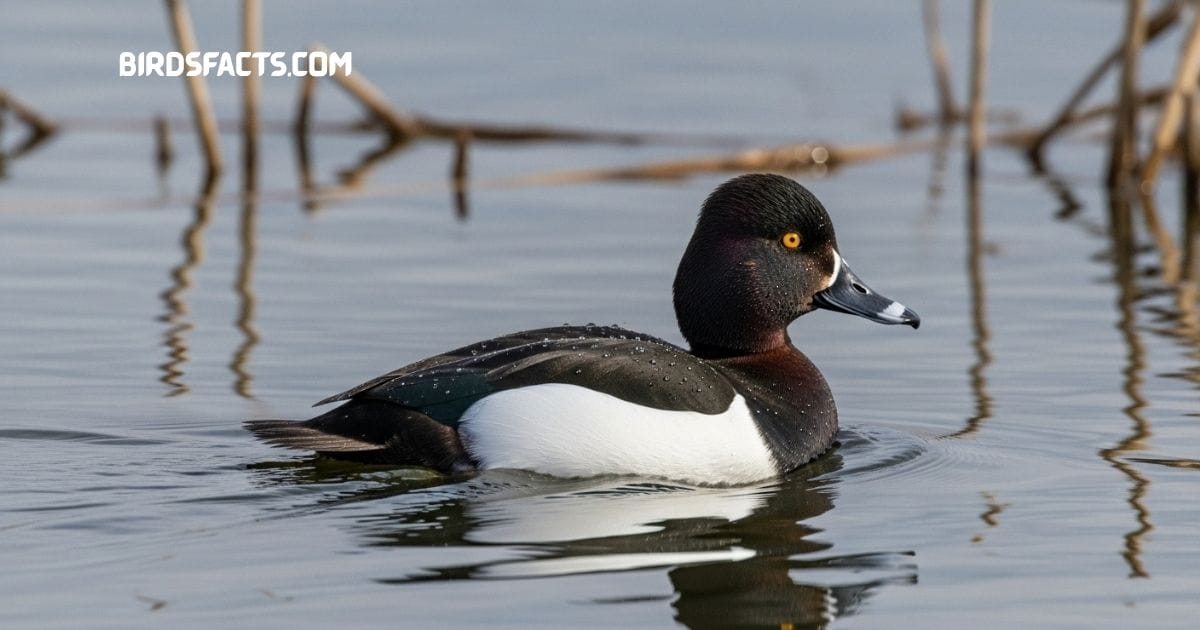
Ring-necked Duck with black back, gray sides, and golden eyes swimming on a lake
The Ring Necked Duck Is A Diving Species That Often Confuses Birdwatchers At First Glance But Is Still A Classic Black And White Duck To Learn About. Males Have Glossy Black Heads Backs And Breasts With Clean White Sides While Females Are Brown With A White Eye Ring And Facial Markings. Despite Its Name The Ring Around The Neck Is Faint And Rarely Seen In The Field. The Sharp Contrast In The Male’s Plumage Makes Identification Much Easier.
This Species Is A Strong Diver Feeding On Submerged Plants Seeds And Aquatic Insects. Ring Necked Ducks Are Frequently Spotted In Freshwater Lakes Ponds And Marshes Across North America During Migration Seasons. They’re Also Social Birds Often Joining Large Mixed Flocks Of Scaup And Other Diving Ducks. For Bird Watchers Adding This Elegant Black And White Duck To Their Life List Is Always Rewarding.
| Fact | Details |
|---|---|
| Habitat | Lakes Ponds Marshes |
| Diet | Seeds Aquatic Plants Insects |
| Special Feature | Faint Chestnut Neck Ring (Hard To See In The Field) |
| Fun Fact | Often Forms Mixed Flocks With Scaup Species |
Smew
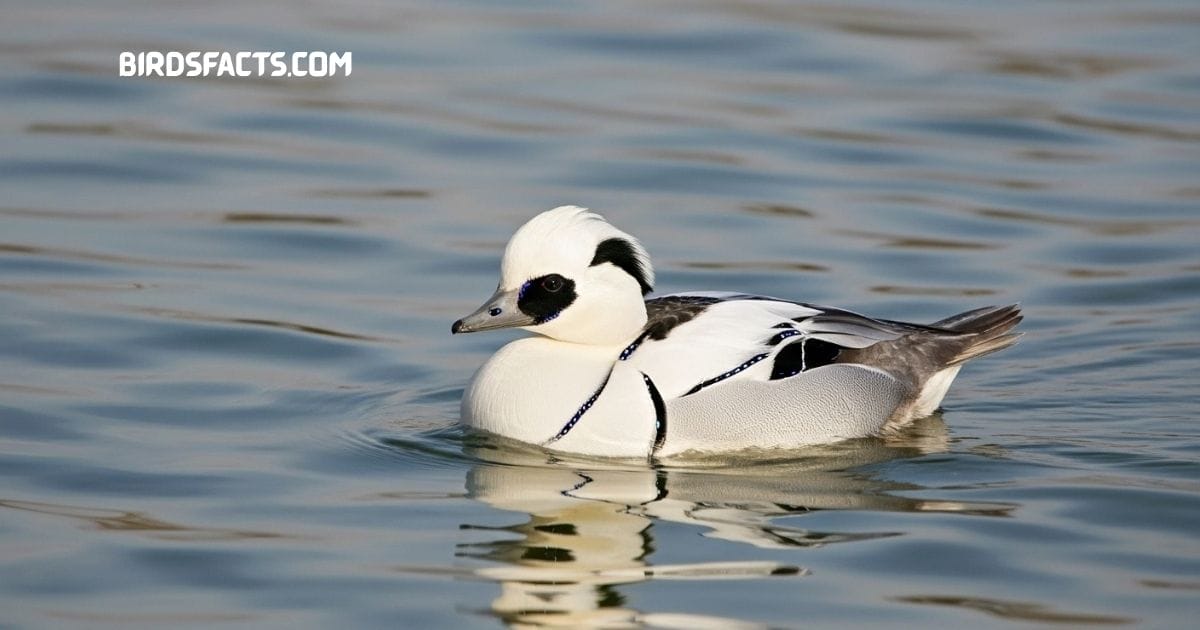
Smew duck with striking black-and-white plumage swimming on a lake
The Smew Is One Of The Most Beautiful And Exotic Black And White Duck Species Found In Europe And Asia. Males Are Easily Recognized By Their Pure White Bodies With Striking Black Patches That Almost Resemble A Panda Bear. Females Nick Named “redheads ” Wear Gray Plumage With Reddish Brown Heads. Their Crisp Markings And Rarity Make Smew A Favorite Among Bird Watchers And Photographers.
Smews Are Excellent Divers Feeding Primarily On Small Fish Crustaceans And Aquatic Insects. During Winter They Migrate To Lakes Rivers And Estuaries Where They Can Be Spotted In Small Groups. Because Of Their Contrasting Colors The Males Stand Out Dramatically Against Icy Land Scapes. Seeing A Smew In Its Natural Habitat Is Considered One Of The Most Exciting Experiences For Anyone Studying Black And White Duck Species.
| Fact | Details |
|---|---|
| Habitat | Lakes Rivers Winter Estuaries |
| Diet | Small Fish Insects Crustaceans |
| Special Feature | Males Resemble “Panda Ducks” With Crisp Markings |
| Fun Fact | Females Are Nicknamed “Redheads” Due To Their Chestnut Heads |
Spectacled Eider
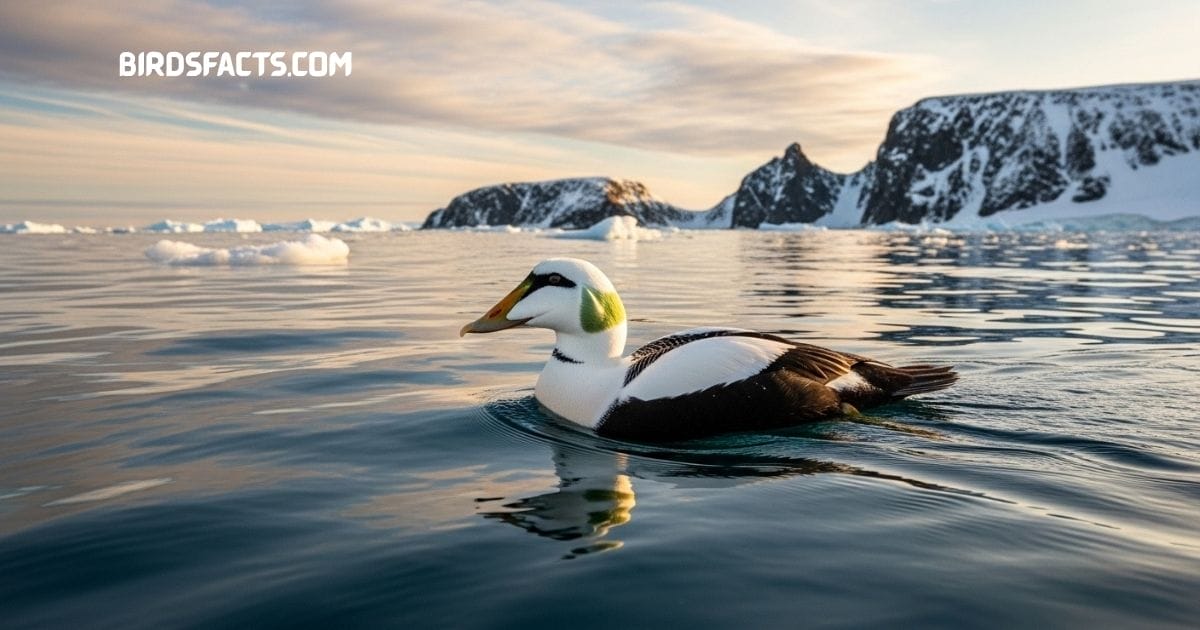
Spectacled Eider duck with white face patches around eyes swimming on Arctic water
The Spectacled Eider Is A Rare And Endangered Black And White Duck Native To Arctic Regions Of Alaska And Siberia. Males Are Striking With Bold White Patches Around Their Eyes Resembling A Pair Of Spectacles. Their Bodies Display Contrasting Black And White Plumage That Sets Them Apart From Other Eiders. Females Are Mottled Brown But Still Show Faint Facial Markings That Hint At The “spectacled” Look.
These Ducks Are Sea Specialists Feeding Mainly On Mollusks Clams And Marine Invertebrates. They Often Winter In Large Flocks On Icy Seas Where They Huddle Together For Warmth And Protection. Because Of Habitat Loss And Climate Change Spectacled Eiders Are Considered Vulnerable Making Them A Highly Sought After Sighting For Dedicated Bird Watchers. For Anyone Fascinated By Arctic Water Fowl This Is One Of The Most Unique Black And White Duck Breeds To Encounter.
| Fact | Details |
|---|---|
| Habitat | Arctic Tundra Icy Coastal Seas |
| Diet | Mollusks Clams Marine Invertebrates |
| Special Feature | Distinctive “Spectacle” Eye Markings |
| Fun Fact | Winters In Dense Flocks On Sea Ice Openings |
Surf Scoter

Surf Scoter duck with black plumage and colorful bill swimming on the sea
The Surf Scoter Is A Bold Sea Duck That Stands Out As A Striking Black And White Duck Species. Males Are Mostly Black But Carry Distinctive White Patches On The Forehead And Nape While Their Colorful Swollen Orange Bills Add A Splash Of Brightness. Females Are Darker Brown With Subtler Face Markings. Surf Scoters Are Often Found Riding Ocean Waves Which Is Why They Earned The Nickname “skunk-headed Coot.”
These Ducks Are Strong Divers Feeding Primarily On Mussels Clams And Crustaceans In Coastal Waters. During Winter Large Flocks Gather Along Sea Coasts And Estuaries Making Them Easier To Spot. Their Bold Facial Markings And Unique Profile Make Them A Favorite Among Coastal Bird Watchers. Among Sea Ducks The Surf Scoter Is One Of The Most Recogniz Able Black And White Duck Species In North America.
| Fact | Details |
|---|---|
| Habitat | Coastal Seas Estuaries Bays |
| Diet | Mussels Clams Crustaceans |
| Special Feature | Males Have White Forehead And Nape Patches |
| Fun Fact | Nicknamed “Skunk-Headed Coot” |
Tufted Duck
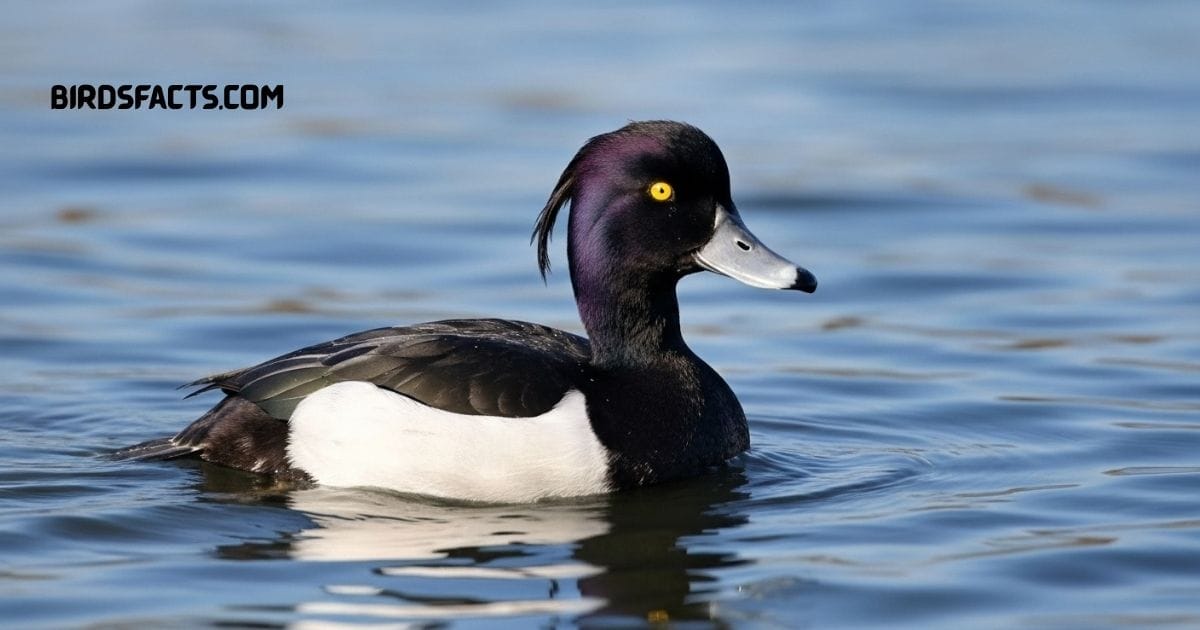
The Tufted Duck Is A Popular European Black And White Duck Known For Its Stylish Crest. Males Display Glossy Black Plumage With Striking White Flanks And A Distinctive Head Tuft While Females Are Brown With Subtle Facial Markings Their Crisp Black And White Contrast Makes Them Stand Out Even In Large Flocks Of Water Fowl.
They Are Diving Ducks Feeding On Aquatic Plants Insects And Mollusks. Tufted Ducks Are Commonly Found On Lakes Rivers And Ponds Across Europe And Asia But They Also Migrate To Warmer Areas In Winter. Their Bold Looks And Tufted Crests Make Them Easy To Identify Even For Beginner Bird Watchers For Many Enthusiasts The Tufted Duck Is A Perfect Introduction To Identifying Black And White Duck Species.
| Fact | Details |
|---|---|
| Habitat | Lakes Ponds Rivers |
| Diet | Aquatic Plants Insects Mollusks |
| Special Feature | Tufted Crest On The Head (Males) |
| Fun Fact | Commonly Found In Large Flocks During Winter |
Velvet Scoter

Velvet Scoter duck with dark plumage and white wing patches swimming on the sea
The Velvet Scoter Is A Large Sea Duck And Another Impressive Black And White Duck Species Found In Northern Europe And Asia. Males Are Mostly Black With A White Patch Below The Eye And A White Wing Stripe That Flashes During Flight. Females Are Dark Brown But Still Carry The Characteristic Pale Facial Patch. Their Power Ful Bodies And Contrasting Plumage Make Them Easy To Identify.
Velvet Scoters Are Deep Divers Feeding On Mollusks Crustaceans And Small Fish In Coastal Seas And Estuaries. They Are Known For Forming Large Rafts On The Ocean During Migration And Winter. Because Of Their Bold Looks And Strong Flight They Are A Prized Sighting For Bird Watchers In Europe. As A Member Of The Scoter Family The Velvet Scoter Is A Standout Black And White Duck Along Northern Coasts.
| Fact | Details |
|---|---|
| Habitat | Coastal Seas Estuaries |
| Diet | Mollusks Fish Crustaceans |
| Special Feature | White Eye Patch And Wing Stripe (Males) |
| Fun Fact | Known To Form Large Winter Rafts On The Ocean |
White-winged Scoter

White-winged Scoter duck with dark plumage and bold white wing patches swimming on water
The White Winged Scoter Is The Largest North American Scoter And A Classic Black And White Duck Of Coastal Waters. Males Are Mostly Black With Bold White Wing Patches And A Crescent Shaped Mark Under The Eye. Females Are Dark Brown But Carry Subtle Lighter Patches Around The Eyes And Face. Their Size And Strong Flight Make Them One Of The Most Impressive Sea Ducks To Observe.
These Ducks Are Powerful Divers Feeding On Clams Mussels And Other Shellfish In Deep Coastal Waters. They Gather In Large Flocks During Winter Some Times Numbering In The Thousands Along Sea Coasts. Because Of Their Size And Bold Wing Markings They’re Easier To Spot In Mixed Flocks Of Sea Ducks. For Birdwatchers The White Winged Scoter Is An Unforgett Able Black And White Duck To Add To Their Life List.
| Fact | Details |
|---|---|
| Habitat | Coastal Bays Sea Coasts Estuaries |
| Diet | Clams Mussels Marine Invertebrates |
| Special Feature | White Wing Patches Visible In Flight |
| Fun Fact | Largest Scoter Species In North America |
FAQs
What Are Some Common Black And White Duck Breeds?
Popular Black And White Duck Breeds Include The Ancona Duck Magpie Duck Bufflehead Common Goldeneye And Tufted Duck.
Are Black and White Ducks only wild species?
No They Include Both Domestic Breeds Like The Ancona And Magpie As Well As Wild Ducks Such As The Smew And Common Eider.
Why are Black and White Ducks so popular among birdwatchers?
Their Bold Plumage Unique Patterns And Interesting Behaviors Make Black And White Duck Species Easy To Spot And Exciting To Identify.
Can I Raise Black And White Duck Breeds At Home?
Yes Domestic Breeds Like The Magpie And Ancona Are Friendly Adaptable And Great For Back Yard Flocks.
Where Can I Find Wild Black And White Ducks?
Wild Black And White Duck Species Can Be Seen In Wetlands Rivers Lakes And Coastal Seas Across North America Europe And Asia.
Conclusion
The World Of Black And White Duck Breeds Is Filled With Variety Charm, And History. From Domestic Breeds Like The Ancona And Magpie To Wild Species Such As The Smew Common Eider And King Eider Each Bird Carries Its Own Story. Their Bold Plumage Patterns Make Them Stand Out Instantly But What Makes Them Even More Fascinating Are Their Unique Habits Some Dive To Incredible Depths Others Migrate Across Continents While A Few Are Loved In Farms And Back Yards.
For Bird Watchers Spotting A Rare Black And White Duck Is Often A Once In A Lifetime Highlight And For Farmers Raising These Ducks Brings Both Beauty And Utility. Beyond Their Striking Appearance These Ducks Remind Us Of The Importance Of Preserving Wetlands Rivers And Coastal Habitats Where They Thrive. So The Next Time You See A Black And White Duck Gliding On Water Remember You’re Witnessing One Of Nature’s Most Elegant Designs A Living Mix Of Beauty Behavior And Resilience.

